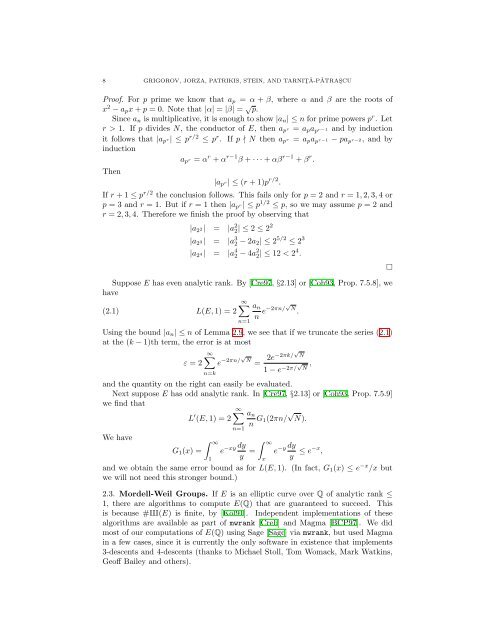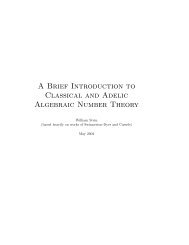COMPUTATIONAL VERIFICATION OF THE BIRCH ... - William Stein
COMPUTATIONAL VERIFICATION OF THE BIRCH ... - William Stein
COMPUTATIONAL VERIFICATION OF THE BIRCH ... - William Stein
You also want an ePaper? Increase the reach of your titles
YUMPU automatically turns print PDFs into web optimized ePapers that Google loves.
8 GRIGOROV, JORZA, PATRIKIS, STEIN, AND TARNIT¸ Ǎ-PǍTRAS¸CU<br />
Proof. For p prime we know that ap = α + β, where α and β are the roots of<br />
x 2 − apx + p = 0. Note that |α| = |β| = √ p.<br />
Since an is multiplicative, it is enough to show |an| ≤ n for prime powers p r . Let<br />
r > 1. If p divides N, the conductor of E, then ap r = apa p r−1 and by induction<br />
it follows that |ap r| ≤ pr/2 ≤ p r . If p ∤ N then ap r = apa p r−1 − pa p r−2, and by<br />
induction<br />
ap r = αr + α r−1 β + · · · + αβ r−1 + β r .<br />
Then<br />
|ap r| ≤ (r + 1)pr/2 .<br />
If r + 1 ≤ p r/2 the conclusion follows. This fails only for p = 2 and r = 1, 2, 3, 4 or<br />
p = 3 and r = 1. But if r = 1 then |ap r| ≤ p1/2 ≤ p, so we may assume p = 2 and<br />
r = 2, 3, 4. Therefore we finish the proof by observing that<br />
|a 2 2| = |a 2 2| ≤ 2 ≤ 2 2<br />
|a 2 3| = |a 3 2 − 2a2| ≤ 2 5/2 ≤ 2 3<br />
|a 2 4| = |a 4 2 − 4a 2 2| ≤ 12 < 2 4 .<br />
Suppose E has even analytic rank. By [Cre97, §2.13] or [Coh93, Prop. 7.5.8], we<br />
have<br />
∞<br />
(2.1) L(E, 1) = 2<br />
n=1<br />
an<br />
n e−2πn/√ N .<br />
Using the bound |an| ≤ n of Lemma 2.9, we see that if we truncate the series (2.1)<br />
at the (k − 1)th term, the error is at most<br />
∞<br />
ε = 2<br />
n=k<br />
e −2πn/√ N = 2e −2πk/√ N<br />
1 − e −2π/√ N ,<br />
and the quantity on the right can easily be evaluated.<br />
Next suppose E has odd analytic rank. In [Cre97, §2.13] or [Coh93, Prop. 7.5.9]<br />
we find that<br />
We have<br />
L ′ (E, 1) = 2<br />
∞<br />
G1(x) =<br />
1<br />
∞<br />
n=1<br />
−xy dy<br />
e<br />
y =<br />
an<br />
n G1(2πn/ √ N).<br />
∞<br />
x<br />
−y dy<br />
e<br />
y ≤ e−x ,<br />
and we obtain the same error bound as for L(E, 1). (In fact, G1(x) ≤ e −x /x but<br />
we will not need this stronger bound.)<br />
2.3. Mordell-Weil Groups. If E is an elliptic curve over Q of analytic rank ≤<br />
1, there are algorithms to compute E(Q) that are guaranteed to succeed. This<br />
is because #X(E) is finite, by [Kol91]. Independent implementations of these<br />
algorithms are available as part of mwrank [Creb] and Magma [BCP97]. We did<br />
most of our computations of E(Q) using Sage [Sage] via mwrank, but used Magma<br />
in a few cases, since it is currently the only software in existence that implements<br />
3-descents and 4-descents (thanks to Michael Stoll, Tom Womack, Mark Watkins,<br />
Geoff Bailey and others).
















